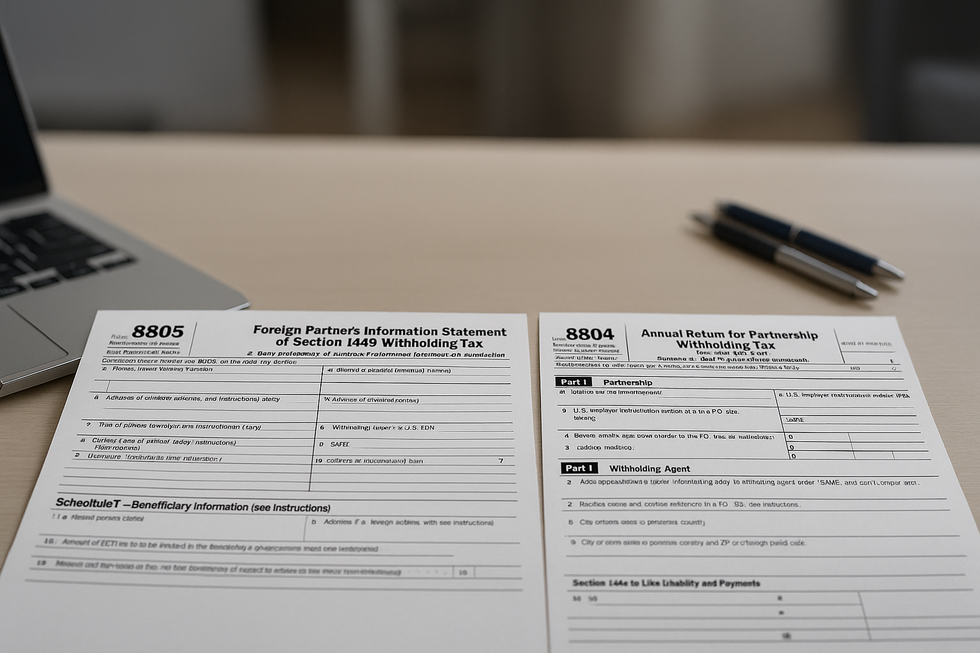Tax Forms 8805 & 8804: Foreign Partner's Information Statement of Section 1446 Withholding Tax

This article is for informational purposes only and does not constitute legal or tax advice.
Always consult with a tax professional for your specific circumstances.
When a U.S. partnership involves foreign partners, it's crucial to understand the tax implications and reporting requirements.
Forms 8805 and 8804 play a pivotal role in ensuring that foreign partners meet their U.S. tax obligations.
Let's delve into the specifics of these forms and their significance, and the broader concept of partnership withholding.
What is partnership withholding?
Partnership withholding refers to the process where a partnership retains a portion of the distributive share of a foreign partner's income, ensuring that the U.S. tax obligations on that income are met.
This withheld amount is then remitted to the IRS.
Understanding Form 8805
Form 8805, titled "Foreign Partner's Information Statement of Section 1446 Withholding Tax," is used by partnerships to provide information to a foreign partner about its share of effectively connected taxable income (ECTI) and the total tax credit allocable to it for the partnership's tax year.
Key features
- Purpose: To report the foreign partner's share of ECTI and the total tax credit allocable.
- Filing Requirement: The partnership files Form 8805 and furnishes a copy to the foreign partner.
- Associated Forms: Along with Form 8805, the partnership must provide each foreign partner with a Schedule K-1 (Form 1065), which reports the partner’s share of income, deductions, and credits.
Form 8805 preview
Understanding Form 8804
Form 8804, known as the "Annual Return for Partnership Withholding Tax," is akin to an umbrella form that provides a summary of the various Forms 8805 issued to foreign partners.
Form 8804 is required to be filed by partnerships that have ECTI allocable to foreign partners. This includes both U.S. and foreign partnerships that engage in a trade or business within the United States.
The form serves as an annual return to report the partnership's withholding tax obligations for its foreign partners.
Key Features
- Purpose: To report the total tax liability of the partnership for the tax year.
- Associated Forms: Accompanied by Form 8813 payment voucher for any tax payments required.
Form 8804 preview
What is the withholding rate for partnerships with a foreign partner?
The withholding rate for partnerships with foreign partners is a critical aspect of ensuring tax compliance. This rate is typically determined based on the highest tax rate in effect for the type of foreign partner, whether they are an individual or a corporation.
For individual foreign partners, the rate often corresponds to the maximum individual income tax rate. On the other hand, for corporate foreign partners, the rate is usually set at the top corporate tax rate.
NOTE: these rates can vary depending on the nature of the income. For instance, certain types of income, such as dividends or capital gains, might have different withholding rates.
Moreover, tax treaties between the U.S. and other countries can also influence the withholding rate. If a tax treaty specifies a lower rate, the partnership may withhold at that reduced rate, provided certain conditions are met.
Pro Tip: Given the complexities and potential variations in withholding rates, it's essential to consult the latest IRS guidelines to determine the exact rate for a given tax year.
Also, leveraging the expertise of a tax pro can provide clarity and ensure compliance.
Exceptions to partnership withholding
There are specific scenarios where partnership withholding may not be required:
- The foreign partner's share of ECTI is effectively zero.
- The partnership receives a valid withholding certificate from the foreign partner claiming an exemption due to a tax treaty.
- The income is not fixed or determinable annual or periodic income.
Compliance and deadlines
Adherence to deadlines is paramount to avoid penalties.
Typically, both forms must be filed by the 15th day of the third month following the close of the partnership’s tax year. For many, this translates to a March 15th deadline.
Extensions can be requested using IRS Form 7004.
Penalties for non-compliance
Non-compliance can be costly.
If Form 8804 is not filed on time, the penalty is usually 5% of the unpaid tax for each month the return is late, up to a maximum of 25% of the unpaid tax.
However, penalties might be waived if the partnership can demonstrate reasonable cause for the delay.
Common mistakes and best practices
Accuracy is paramount when completing these forms.
Some common pitfalls include:
- Not reviewing the latest IRS instructions.
- Submitting incorrect partnership and partner information.
- Inaccurate calculation of ECTI and partner allocations.
To ensure accuracy, always consider consulting with a tax professional.
Never had pro tax help before?
Check out how it works
Bottom line
Understanding and complying with the requirements of Forms 8805 and 8804 is essential for partnerships with foreign partners. Proper adherence ensures transparency, fosters trust, and avoids potential financial pitfalls.

Stay IRS-compliant with your business abroad – we’re ready to help


